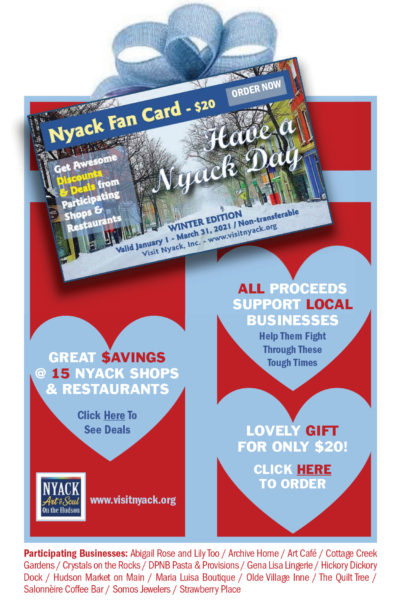
Not only was it the hottest 4th of July on record but it was also the loudest, proudest, and longest 4th of July parade ever in Nyack. In 1919, a huge memorial arch over S. Broadway, our very own Arc de Triomphe, decorated the parade route through which veterans, villagers, and bands marched not once but twice.
The cadenced tramping of some 225 men home from Europe, the crashing of band music, the fluttering of hundreds of flags under a blue sky, and a single white plane overhead dipping its wings entertained a cheering throng crowding the sidewalks, windows, porches, automobiles, and even roofs. The voices of women called out “Billy” and “Charley” and “Jack”. Nyack welcomed its sons back home with clapping, speeches, and special medals.
A Long Holiday Weekend
It was a busy weekend in the village after the morning parade. The Children’s Home at Mont-Lawn, better known as the Christian Herald Children’s Home (now the home of Camp Ramah) opened with many children from NYC for a two-week holiday. At the baseball field across from Nyack Hospital, the Navy boys beat Army, 8 to 7. Nyack Beach was packed with picnickers and bathers who came by car or on foot. The Nyack Evening Journal opined that the men who arrived on foot in a onesie or with little trunks over their jerseys should not have been allowed.



In the evening, the Nyack Fire Patrol held a dance at the Central Fire Station on Park Street featuring the singing of the McCormick brothers of South Nyack. A $10 door prize was awarded. At the “government place” where the Nyack Post Office is now located, the Tappan Zee Military Band gave a concert. The ‘government place’ was so named because the federal government had acquired land for a new post office in 1910 but let it sit empty for 20 years until a new post office was built.
In the evening, the Nyack Fire Patrol held a dance at the Central Fire Station on Park Street featuring the singing of the McCormick brothers of South Nyack. A $10 door prize was awarded. At the “government place” where the Nyack Post Office is now located, the Tappan Zee Military Band gave a concert. The ‘government place’ was so named because the federal government had acquired land for a new post office in 1910 but let it sit empty for 20 years until a new post office was built.


Shops were closed, but the flag-festooned Broadway Theater on the parade route held a showing of I’ll Get Him Yet featuring Lillian Gish, a newsreel, and a return engagement of Charlie Chaplin’s A Night in the Show.
The Memorial Arch
Members of the WWI veteran’s homecoming committee came up with the idea of building Nyack’s own version of the Arc de Triomphe over Broadway. John M. Rooney, a well-known mason, builder, and contractor from S. Nyack, presented a petition to the Village Board to erect the memorial arch. It was approved. By March the arch was near completion and being painted white. Four ionic columns supported a cross bar from which hung a wreath and an unusual American flag, with a blue-starred field outside the red and white stripes.

The arch remained long after the 4th of July celebration; in fact, it took a petition for removal signed by 33 villagers in December to suggest to the Board that the arch was now unsafe. Despite objections from some villagers who argued that it should be saved as a permanent Nyack war memorial, the arch was removed by December 31, 1919.
The 4th of July Parade
The parade started at 9:20a at Empire Hook and Ladder Company firehouse in Upper Nyack. The route was three miles long. Participants marched down Broadway to First Avenue, turning west on Franklin, continuing to Main St., and then on Main through downtown Nyack and turning south onto Broadway. Marchers passed under the memorial arch at Hudson Ave. and continued until they made a left on Cornelison, a left on Piermont Ave, a left on Mansfield, and then turned back onto Broadway, heading north back to the memorial arch. The parade ended at a reviewing stand that was set up near the arch at the “government place.”

Veterans assembled at the Business Men’s Club at 35 N. Broadway. Red cross volunteers assembled at the Red Cross Building on N. Broadway. Flags were distributed to civilians who wanted to march. The march was led by Stewart Walters of the Grand Army of the Republic on a white horse followed by the approximately 13 or so remaining veterans of the Civil War, plus veterans of the Spanish-American War in automobiles. Then came WWI soldiers and sailors in uniform followed by automobiles carrying wounded veterans unable to march that were housed in a recovery hospital in Grand View then known as the Cheer-Up Home. The cars were provided by the Women Motor Corps members. Red Cross volunteers came next.
The Nyack Fire Department, citizens carrying flags, and decorated automobiles and pony carts followed. The Tappan Zee Military Band, the Tarrytown Band, and the Hudson View Council Fife and Drum corps were interspersed between groups. The Sons of Columbus, a society for Italians, marched near the end. Reverend Father Crosby and Reverend A.L. Longley occupied an automobile at the end of the parade.
The End-of-Parade Ceremony

Everyone gathered at the reviewing stand at the ’government place’ across from the Nyack Library at the end of parade. It was quite hot. Some sported umbrellas to ward off the sun, others wore hats or laid a handkerchief over their heads to reflect the intense sun. The ceremony was recorded in a remarkable panoramic photo measuring 35” by 6” by Norman Burke, a Nyack photographer whose studio at 8 S. Broadway had been passed by during the parade.

“America” was sung to start the post-parade ceremony at the reviewing stand. Judge Arthur Tompkins welcomed the veterans home and spoke of sadness for the men who had given their lives, their names marked with a gold star on the honor roll, a large plaque mounted nearby.


Judge William Cunningham of Ellenville, NY, a noted orator who once spoke to 90,000 at Yankee Stadium, gave a speech mostly focused on expressing disapproval of the League of Nations, announcing a need for American isolationism. He. argued that the United States should not act in concert with other countries. It seemed an odd conclusion for the attending troops to hear.

Bronze medals were presented to each soldier or sailor or their representatives. Gold medal were given to seven parents who lost their sons (we know now more were lost during the war). One gold medal was mistakenly given to a returned veteran, and the newspaper on July 5 called for its return.
An Extremely Busy Friday, July 4, 1919
A smattering of fireworks was seen in the village on that Friday night but “they were not those of other days.” Perhaps everyone was too exhausted from so much fun that day. Friday, July 4, 1919, proved to be the longest and grandest 4th of July parade ever in Nyack, a proud salute to those who sacrificed so much for their country.
Michael Hays is a 35-year resident of the Nyacks. Hays grew up the son of a professor and nurse in Champaign, Illinois. He has recently retired from a long career in educational publishing with Prentice-Hall and McGraw-Hill. Hays is an avid cyclist, amateur historian and photographer, gardener, and dog walker. He has enjoyed more years than he cares to count with his beautiful companion, Bernie Richey. You can follow him on Instagram as UpperNyackMike.


 Nyack People & Places, a weekly series that features photos and profiles of citizens and scenes near Nyack, NY, is brought to you by Sun River Health, Nyack Fan Card, and Weld Realty
Nyack People & Places, a weekly series that features photos and profiles of citizens and scenes near Nyack, NY, is brought to you by Sun River Health, Nyack Fan Card, and Weld Realty







